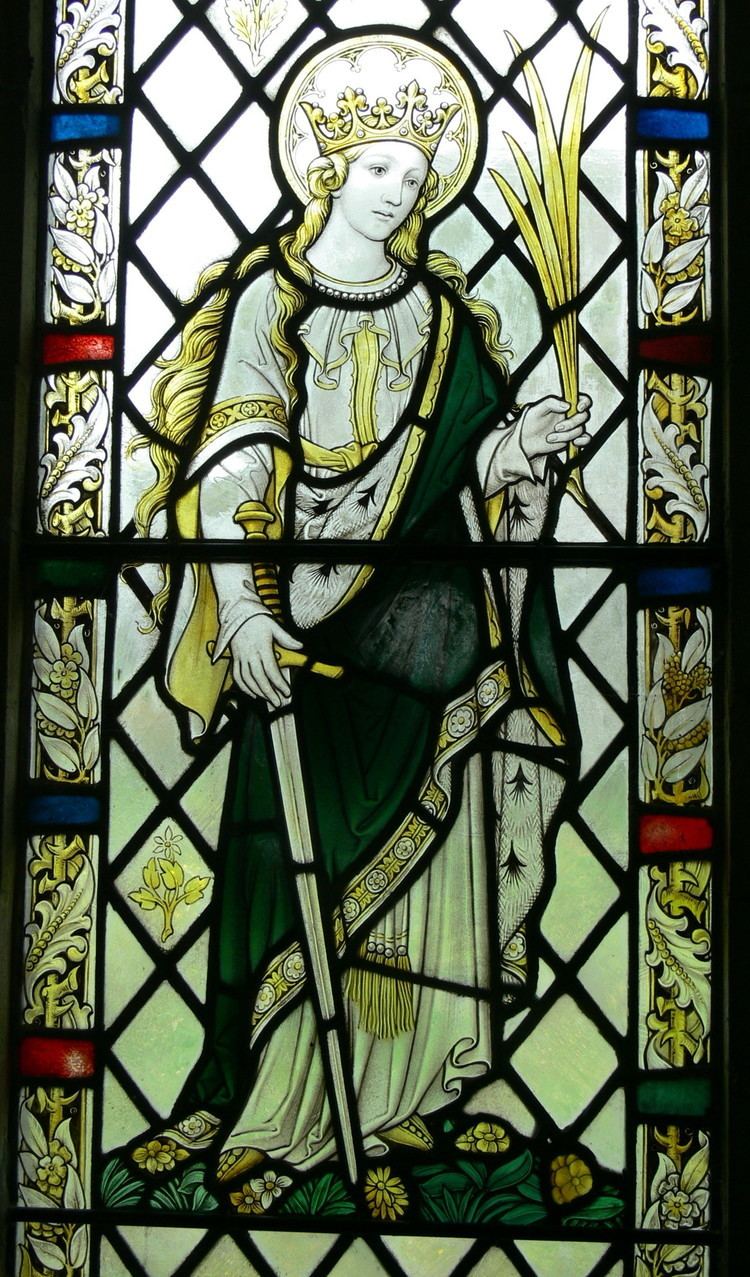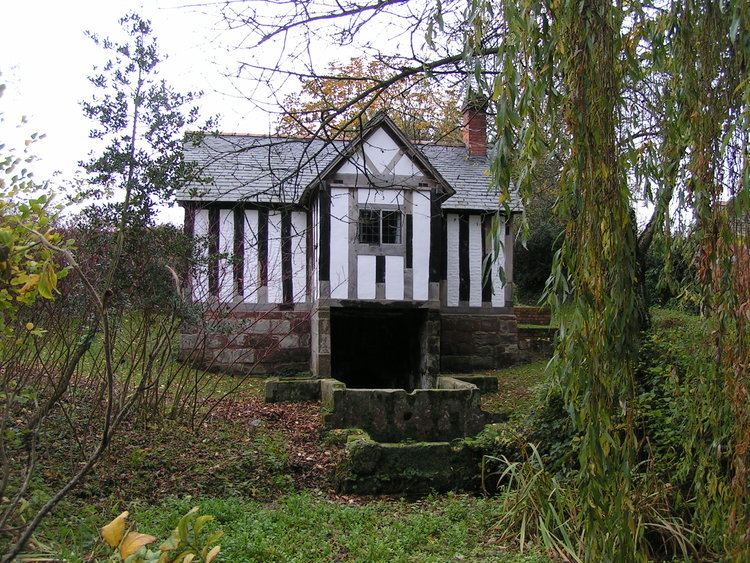Feast 3 November Name Saint Winifred | Patronage Holywell | |
 | ||
Venerated in Eastern Orthodox ChurchRoman Catholic Church Major shrine Shrewsbury Abbey, now destroyed although a small part of the shrine base survives. Holywell, fully active holy well and well-house shrine. Died 660 AD, Gwytherin, United Kingdom | ||
Saint winifred solemn latin mass 2017
Saint Winifred or Saint Winefride (Welsh: Gwenffrewi; Latin: Vinefrida) was a 7th-century Welsh Christian woman, around whom many historical legends have formed. A healing spring at the traditional site of her decapitation and restoration is now a shrine and pilgrimage site called St Winefride's Well in Holywell, Flintshire, Wales and known as the Lourdes of Wales.
Contents
- Saint winifred solemn latin mass 2017
- SAINT WINIFRED Catholic film Welsh Saint Winefried DVD advert
- Legend
- Veneration
- Roman Martyrology
- Iconography
- References

SAINT WINIFRED, Catholic film, Welsh Saint, Winefried, DVD advert
Legend

According to legend, Winifred was the daughter of a chieftain of Tegeingl, Welsh nobleman, Tyfid ap Eiludd. Her mother was Wenlo, a sister of Saint Beuno and a member of a family closely connected with the kings of south Wales. Her suitor, Caradog, was enraged when she decided to become a nun, and decapitated her. In one version of the tale, her head rolled downhill, and, where it stopped, a healing spring appeared. Winifred's head was subsequently rejoined to her body due to the efforts of her maternal uncle, Saint Beuno, and she was restored to life. Seeing the murderer leaning on his sword with an insolent and defiant air, St. Beuno invoked the chastisement of heaven, and Caradog fell dead on the spot, the popular belief being that the ground opened and swallowed him. St. Beuno left Holywell, and returned to Caernarfon. Before he left the tradition is that he seated himself upon the stone, which now stands in the outer well pool, and there promised in the name of God "that whosoever on that spot should thrice ask for a benefit from God in the name of St. Winefride would obtain the grace he asked if it was for the good of his soul." She later became a nun and abbess at Gwytherin in Denbighshire.

After eight years spent at Holywell, Winifred received an inspiration to leave the convent and retire inland. Accordingly, St. Winifred went upon her pilgrimage to seek for a place of rest. Ultimately she arrived at Gwytherin near the source of the River Elwy. More elaborate versions of this tale relate many details of her life, including Winefride's pilgrimage to Rome.

In spite of the slim records for this period, there appears to be a historical basis for this personage. In the old Latin writings about her life a lot of attention is given to a scar on her neck, so she could well have been attacked by Caradog. Winifred's brother Owain is known to have killed Caradog as revenge for a crime. She succeeded the Abbess, Saint Tenoi, who is believed to be her maternal grand-aunt.
Veneration

After her death (c. 660) Winifred was interred at her abbey. In 1138, relics were carried to Shrewsbury to form the basis of an elaborate shrine. The shrine and well became major pilgrimage goals in the Late Middle Ages, but the shrine was destroyed by Henry VIII in 1540.
Whatever the exact truth of her legend, Winefride has been venerated as a saint ever since the moment of her death. Since that time, too, her Well at Holywell has been a place of pilgrimage and healing – the only such place in Britain with a continuous history of public pilgrimage for over 13 centuries. The well itself, originally formed from a mountain spring, is housed below the town on the side of a steep hill in the shrine of St. Winifride (Gwenffrwd or Gwenfrewi), regarded as one of the finest surviving examples of a medieval holy well in Britain. The Well precinct also houses an Interpretive Exhibition setting forth the story of the saint and her shrine in detail; and the Victorian former custodians' house has been converted to house a museum of the pilgrimage.
Another well named after St Winifred is in the hamlet of Woolston near Oswestry in Shropshire. It is thought that on her way to Shrewsbury Abbey, Winifred's body was laid here overnight and a spring sprang up out of the ground. The water is supposed to have healing powers and be good at healing bruises, wounds and broken bones. The well is covered by a 15th-century half-timbered cottage. The water flows through a series of stone troughs and into a large pond, which then flows into a stream. The cottage is in a quiet, peaceful setting in the middle of the countryside, and is maintained by the Landmark Trust.
Another spring supposedly arising from the laying down of Winifred's body is at Holywell Farm, midway between Tattenhall and Clutton, Cheshire. There is a spring in the garden of this non-working farm which supplies two houses with their drinking water.
A spring on Lansdown Hill, Bath was known as St. Winifred's Spring and has given its name to nearby Winifreds Lane. There appears to be no known connexion to the life of the saint, but its waters were once supposed to help women conceive.
A Norman church dedicated to Saint Winifred can be found in the village of Branscombe, Devon. There is some archaeological evidence to suggest an earlier Saxon church may have occupied the site.
Roman Martyrology
In the 2004 edition of the Roman Martyrology, Winefride is listed under 2 November with the Latin name Winefrídae. She is listed as follows: 'At the spring located at Holywell in Wales, St Winefride the Virgin, who is outstanding in her witness as a nun'. Thus Winifred is officially recognised by the Vatican as a person with a historical basis, who lived an exemplary religious life, but with no discussion of miracles which she may have performed or been healed by. As a first-millennium saint, she is recognised as a saint by popular acclaim, rather than ever being formally canonized.
In the current Roman Catholic liturgical calendar for Wales, she is commemorated on 3 November, since 2 November is designated as All Souls' Day.
Iconography
Her representation in stained glass at Llandyrnog and Llanasa focusses on her learning and her status as an honorary martyr, but the third aspect of her life, her religious leadership, is also commemorated visually. On the seal of the cathedral chapter of St Asaph (now in the National Museums and Galleries of Wales, Cathays Park, Cardiff), she appears wimpled as an abbess, bearing a crozier, symbol of leadership and authority and a reliquary.
